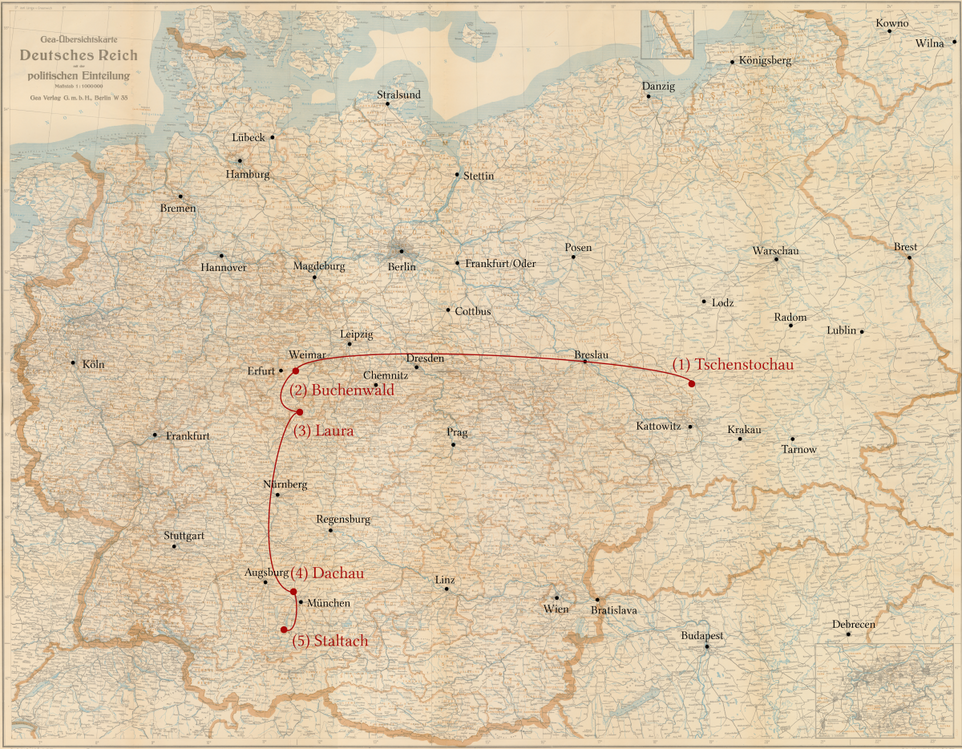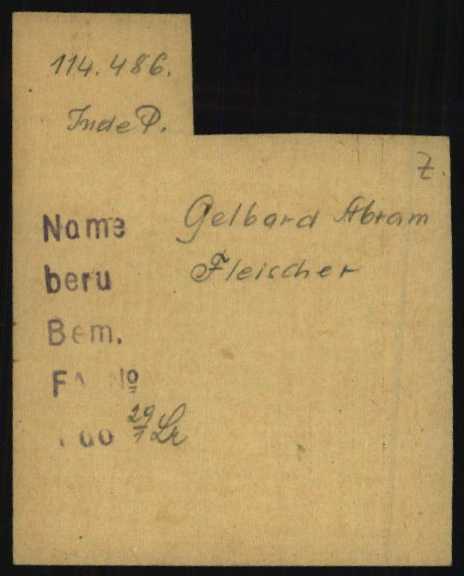The Biography of Abraham Gelbart, Tschenstochau
Short biography and stations of his persecution
- Born on 19 December 1910 in Częstochowa/Poland,
- Czestochowa ghetto, forced labour camp HASAG Czestochowa,
- 17 January 1945 Buchenwald concentration camp, prisoner number 114486
- 29 January 1945 Buchenwald concentration camp/Laura subcamp
- 13 April 1945 Dachau concentration camp
- 30 April 1945 Liberation near Staltach
- Feldafing, Bieberach, Tutzing, Stuttgart
- 1948 Israel
Fates of relatives and loved ones: Mother perished in the concentration camp at the age of 66, 6 brothers and 4 sisters murdered in the camp. He survived alone.
Married in 1934, wife in a pregnant state and his child murdered in the Treblinka concentration camp.
Source: Medical report dated 28.5.1961
Tschenstochau, HASAG
In the Czenstochau ghetto and in the Hassag Pelcery munitions factory, I had to carry out the heaviest forced labour, which was far beyond my strength. This involved unloading and loading coal, stones and other various hard labour. At the Hassag Pekcery munitions factory, I had to work hard for 12 hours, day or night shift.
I had to handle hydrochloric acid without the necessary protective measures. My gloves and shoes, which I had received for the first time, were eaten away by the hydrochloric acid and perforated. I had rashes with pus wounds, the acid got on these wounds, burnt them even more, the pain was unbearable, I had to keep working. You can still see scars from badly healed burns on my arms and feet today.
Immediately after the Germans marched in, I witnessed how my younger brother Jakob, together with 62 other Jews - my brother was 20 years old - was shot. My mother was transported from Czenstochau to Treblinka, where she perished. My other siblings, who lived in Klobuck - only about 17 kilometres from Czenstochau, were transported away and perished. (Some in Treblinka, some in Auschwitz). My first wife, with my daughter of 11 years, was deported to Treblinka, together with my mother. My wife was 9 months pregnant. They all perished.
I suffered a terrible shock when I was taken to be shot together with 300 other prisoners. I escaped certain death because my master supervisor, I think I know his name was Niziolek, pulled me out of the crowd because I was a good worker and he needed me.
Another difficult experience was when I once came into the camp after a hard night shift, undressed and went to bed and was immediately asked to go to dig trenches. Because I had dared to say that I had only come back half an hour ago after a hard night shift, I was punished in the following way. It was a heavy winter, I had to walk barefoot and undressed, wearing only a shirt, 30-40 times around the entire assembly area and was beaten with rubber truncheons. The SS man who had organised it was called Deggenhart.
I was also very often severely abused during forced labour. After the liberation, I was in a state of complete mental and physical exhaustion and ill.
| Zwangsarbeitslager für Juden im "Generalgouvernement" | |
|---|---|
| Ort | Częstochowa / Tschenstochau |
| Bezeichnung | HASAG Pelzery |
| Gebiet | Generalgouvernement, Distrikt Radom (1939-1945) |
| Eröffnung | 22.09.1942; Lager für Frauen: 22.09.1942 (erste Erwähnung) |
| Schließung | Befreiung am 16.01.1945 |
| Deportationen | |
| Häftlinge | |
| Geschlecht | Männer und Frauen |
| Einsatz der Häftlinge bei | HASAG (Hugo Schneider AG) Pelzery-Apparatebau |
| Art der Arbeit | Arbeit in der Munitionsfabrik |
| Bemerkungen | Im Juli 1943 führte die Polizei Massenerschießungen im Lager durch. Am 20. Juli wurden 400 Personen erschossen. |
| Quelle: deutschland-ein-denkmal.de | |
Buchenwald/Laura
After the War
After liberation, I was cared for in the outpatient clinic of the surgical department of the D.P. Hospital in Landsberg. Dr Dobrzynski was one of the doctors. I later lived in Stuttgart, but often went to Dr Dobrzynski for treatment. I still knew him from Czenstochau. I was in poor health in Germany and couldn't work.
When I came to Israel in 1948, I still couldn't work.
Notes
Further Sources
- Ghetto Tschenstochau (memorialmuseums.org)
- Ghetto Tschenstochau (holocaustmemorialproject.org)
- Ghetto Tschenstochau (deathcamps.org)
- Ghetto Tschenstochau (wikipedia)
- Ghetto Tschenstochau (sztetl.org)
- HASAG (14.3.2023)
- Gedenkstätte "Zwangsarbeit in Leipzig"
Office for Compensation
Stuttgart ES/A 6809 (0)-II Mz/Goe.; ES/A 19672
Notes
---
Picture Credits
- Karte von Tschenstochau, 1935 (Mapster), mit Angaben von deathcamps.org
- Häftlings-Personal-Karte Abraham Gelbart, Individuelle Häftlingsunterlagen - KL Buchenwald 1.1.5.3/5935324/ITS Digital Archive, Arolsen Archives
- Arbeitseinsatzkarte Abraham Gelbart, Individuelle Häftlingsunterlagen - KL Buchenwald 1.1.5.3/5935325/ITS Digital Archive, Arolsen Archives, Erläuterungen siehe e-guide



